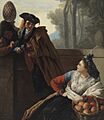José del Castillo facts for kids
José del Castillo (born October 14, 1737, died October 5, 1793) was a Spanish artist from Madrid. He was a talented painter and engraver who worked in the Neoclassical style. This style was popular in his time and focused on clear lines and calm scenes, often inspired by ancient Greek and Roman art. José del Castillo is especially known for designing many beautiful tapestries.
Contents
Life as an Artist
Early Training and Studies
José del Castillo started his art journey very young. When he was just ten years old, he became an assistant in drawing classes at the Real Academia de Bellas Artes de San Fernando in Madrid. He was so good that in 1751, a very important person, the Secretary of State, José de Carvajal y Lancaster, gave him money to study in Rome.
In Rome, he learned from a famous artist named Corrado Giaquinto. In 1753, Giaquinto was called back to Spain by King Ferdinand VI, and Castillo went with him. Back at the Academia in Spain, Castillo continued to excel and won a gold medal in 1756.
Two years later, he received more money to continue his studies in Rome. While there, he got married. After finishing his studies, he traveled back to Madrid in 1764, exploring Italy with another artist, Juan de Villanueva.
Working with Tapestries
When José del Castillo returned to Madrid, he immediately started working at the Royal Tapestry Factory. This became his main job. He painted designs and large drawings called "cartoons" (which are like blueprints) for tapestries. He worked under the guidance of Anton Raphael Mengs, another important artist.
At first, Castillo copied works by other artists, like Luca Giordano and his old teacher, Giaquinto. But soon, he started creating his own designs. Many of his designs showed scenes from everyday life in Spain.
Other Art Projects
Even though tapestries were his main focus, José del Castillo also painted religious pictures sometimes. One example is a painting from 1783 that shows Saint Dominic and Saint Francis hugging. You can see this painting at the Basilica of San Francisco el Grande, Madrid.
He also helped illustrate books. He made drawings for a special edition of Don Quixote in 1780. These drawings were later turned into engravings by other artists, Manuel Salvador Carmona and Fernando Selma.
Later Career and Challenges
In 1785, José del Castillo was recognized for his talent and became an Academician of Merit at the Academia. He tried to become a "Painter to the King," which was a very important job, but he wasn't successful.
He also wanted to become the Director of the Royal Tapestry Factory. He had support from a powerful person, Count Floridablanca. However, another painter named Ramón Bayeu was against him and had the support of Count Aranda, who was a favorite at court. Castillo tried again after Bayeu passed away, with recommendations from many artists, but he still didn't get the job. The position was left empty.
Besides painting, Castillo also helped restore art at the Palacio del Buen Retiro. Many of his sketches and engravings are very valuable today because they show works by other artists that have since been lost.
Images for kids
See also
 In Spanish: José del Castillo para niños
In Spanish: José del Castillo para niños



